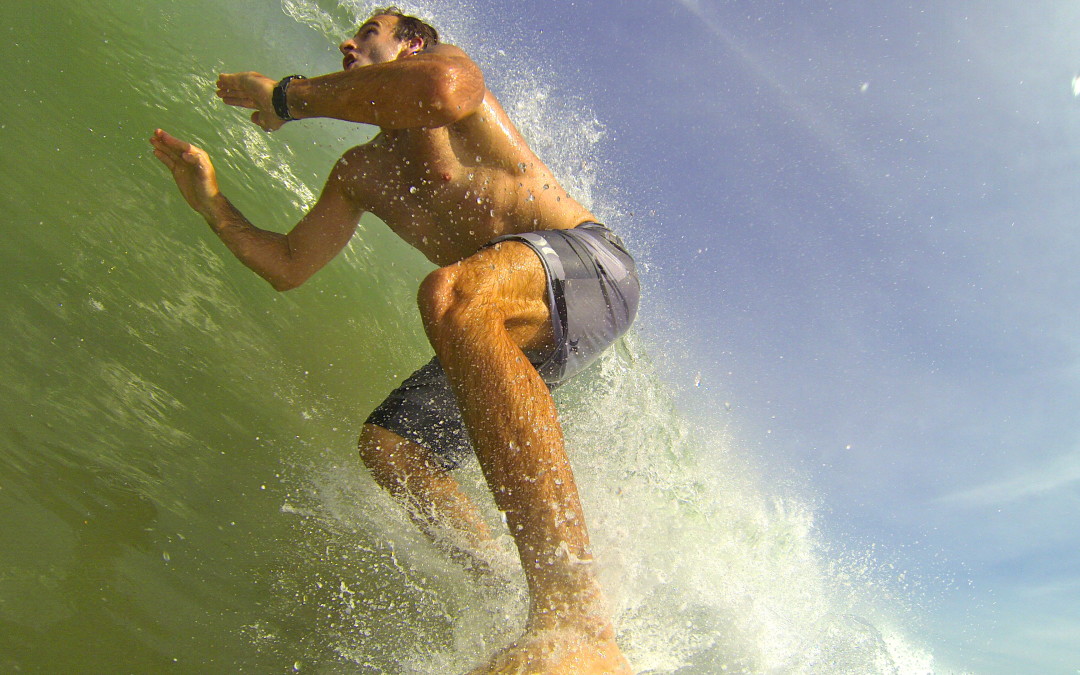The light was soft and green. The sound of crashing water filled my ears.
Left foot in front of right in a full crouch, my front thigh tight with tension, my hands out in front of my body trying to keep it on my surfboard. I couldn’t taste much, and my smell was blunted by the vision of water crashing in front of my board.
Holding on for dear life, I squeezed myself a little bit lower into a deeper crouch. I was running out of room, the wave was almost over…but I had no idea of the time or awareness of my surroundings. I was fully in the moment. Present. No future. No past. No sense of self. Just the board and the moving ocean.
Whoosh..
Down I go into the deep blue. A few seconds of brief discomfort and then I resurface, smiling ear to ear.
Flow state. Yup, that was it. I’ll take another please.
* * * * *
Have you ever been so engaged in a conversation that your afternoon seemed to fly by? Or been so absorbed in a work project that nothing else seemed to matter?
If so, then you too have experienced a flow state. Also known as being in “the zone,” flow represents an optimal state of consciousness, a peak state where we both feel and perform our best. Anyone, anywhere, can experience a flow state, provided certain initial conditions are met.
A Brief Overview of Flow
It’s this state of peak performance among extreme athletes that Steven Kotler explores in his latest book, The Rise of Superman. “Flow is a hyper-focused state,” he explains. “We are so focused on the task at hand that everything else falls away. Action and awareness merge. Time flies. Self vanishes. Performance goes through the roof.”
Expanding on the work of psychologist Mihaly Csikszentmihalyi, Kotler dives deep into the nature of flow states and what makes for optimal human performance. He discovers that adventure athletes, surfers, skiers, snowboarders, white water rafters / kayakers, skateboarders, and mountain bikers have all figured out a way to routinely achieve flow states.
And it’s this consistency in flow states that explains the exponential rate at which athletes have broken records in the last 20 years. Double backflips once thought to be the thing of fantasy are routinely seen on the ski slope. Waves up to 100 feet in height are now being surfed. How are these incredible feats of human performance explained? By flow states.
Applying Flow to Your Life
Kotler’s research illustrates an amazing time in history, in which access to such powerful information is now readily available. High performance secrets are being revealed. Elite training methods and strategies are now being shared after years of secrecy. Experts across disciplines are collaborating, patterns are being recognized, and best practices are being shared.
And by applying these principles to your own life, you can increase your performance, learn faster, and do the otherwise impossible.
This gets me very excited because it means greatness is attainable for everyone, no matter where you are or what you do!
The more that’s studied about human performance, the more apparent it becomes that there really isn’t anyone out there who’s “superhuman” or who has innate abilities of superhuman nature. Average people can achieve greatness. Excellence is available to everyone. Those with “normal” genes can perform at the highest levels.
If you’re looking to achieve your own greatness, finding flow will certainly help. You’ll need to meet at least one of the following conditions:
- High consequence / risk
- Deep focus
- Rich environment
- Challenge
- Clear goals
5 Ways to Hack Your Athletic Flow
In his research, Kotler identified 17 different flow triggers. Here, I dive deeper into the 5 most powerful.
1) High Consequence / Risk – Flip the Script On Your Perception Of Risk
As risk increases, two important neurochemicals are released from the brain that help us focus and perform better. Yet in order to make progress in anything, you’ll need to enjoy risk.
The trick is to change how you perceive risk, by relating it to a challenge instead of danger. For when risk is a challenge, you can use our fear to help guide us and elevate us to a new level. Fear will always be there – using it to our advantage is what’s really important.
This concept reminds me of former boxing trainer Cus D’amato, who once said, “The hero and the coward both feel the same thing, but the hero uses his fear, projects it onto his opponent, while the coward runs. It’s the same thing, fear, but it’s what you do with it that matters.”
When thinking about physical risk, it’s easy to conjure up examples, like a big wave surfer who’s charging a 50-foot wave. But risk can be more than just physical. As research shows, flow can be triggered in introverted men just by walking across the bar and chatting it up with a pretty lady.
While physical risk is certainly an easy access into flow, this doesn’t mean you have to go out and charge 50-foot waves. Mental risks, emotional risks, or creative risks can also trigger the same response.
2) Deep, Intense, Singular Focus – Ditch the Multitasking Already
Long, uninterrupted periods of focus are needed to trigger a flow state – like focusing on a single task for a set amount of time. This is why having a quiet and distraction-free workspace is so vital to producing good work. Flow takes time to build, and it takes just one tiny distraction to snap you out a flow state and catapult you into a multitasking frenzy of unproductivity.
3) Rich Environment – Trigger Flow Through Your Surroundings
Kotler describes rich environments as a combination of novelty, unpredictability, and complexity, all of which attract and hold our attention in much the same way as risk. Take surfing: each wave is unique, unpredictable and novel. Plus, the ocean is as complex an organism as you can get. It’s no accident that surfers often experience flow states.
4) Accurate Skill / Challenge Ratio – Find the Sweet Spot in Your Challenge-to-Skill Ratio
If something is too difficult and or scary, fear spikes and you’ll try to get the hell out. Alternatively, if the task is too boring, you’ll disengage. It’s all about locating that one perfect spot that’s slightly above our skill level, yet still attainable.
Identifying the sweet spot is a little tricky, but it seems to hover around 4% above natural skill levels. It may not be much, but this 4% challenge increase can produce a good flow. A similar and widely studied theory is Yerkes-Dodson law, which finds that increased emotional arousal, such as anxiety, can sharpen performance, but peaks at a certain point. Too much, and you’ll experience a decline in performance.
5) Clear Goals – Know the “why” Behind What You’re Doing
Clarifying the reason behind what you’re doing will keep your brain from wandering or getting distracted. When you’re fully present in the moment, you can stay laser-focused on the task at hand.
* * * * *
Ready to Get Into Flow?
The time is now.
Through ever-advancing technology, you can finally measure and track these states more consistently. And while the consequences of your life might not be as severe as extreme athletes, you can still use the principles of flow to increase performance in whatever area of life you select.
You truly can attain peak performance. Right now.
Join the Conversation below and share how you get into flow





